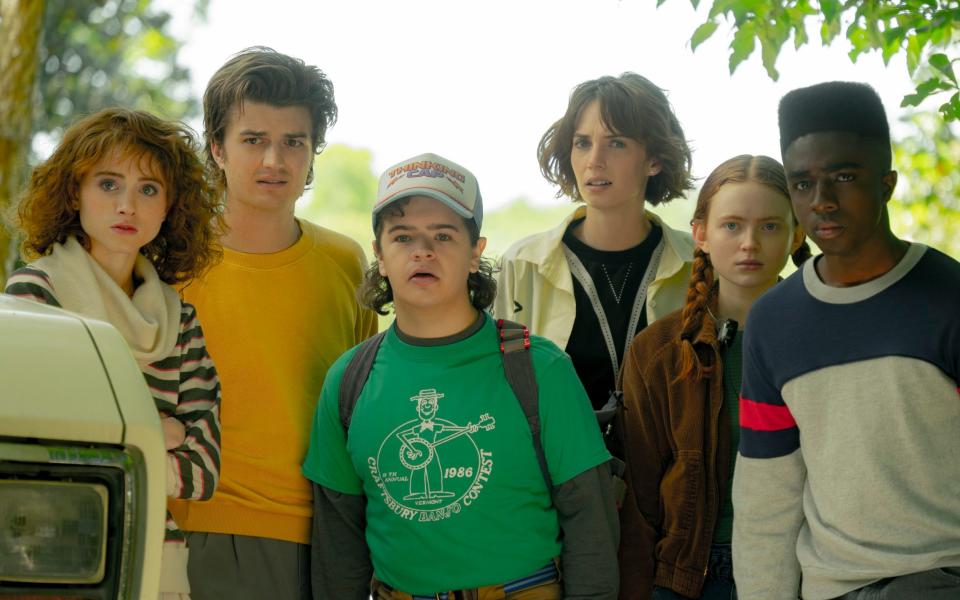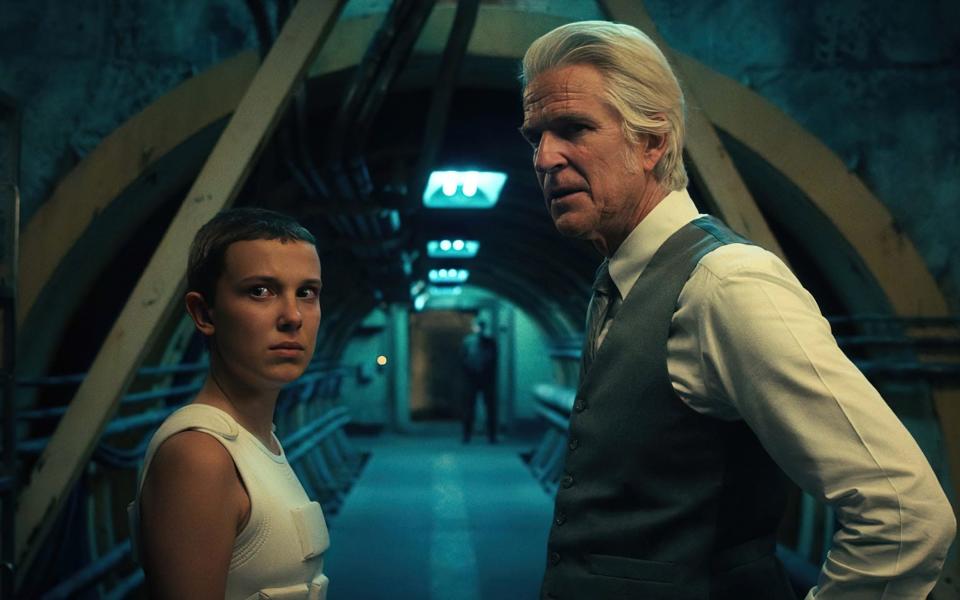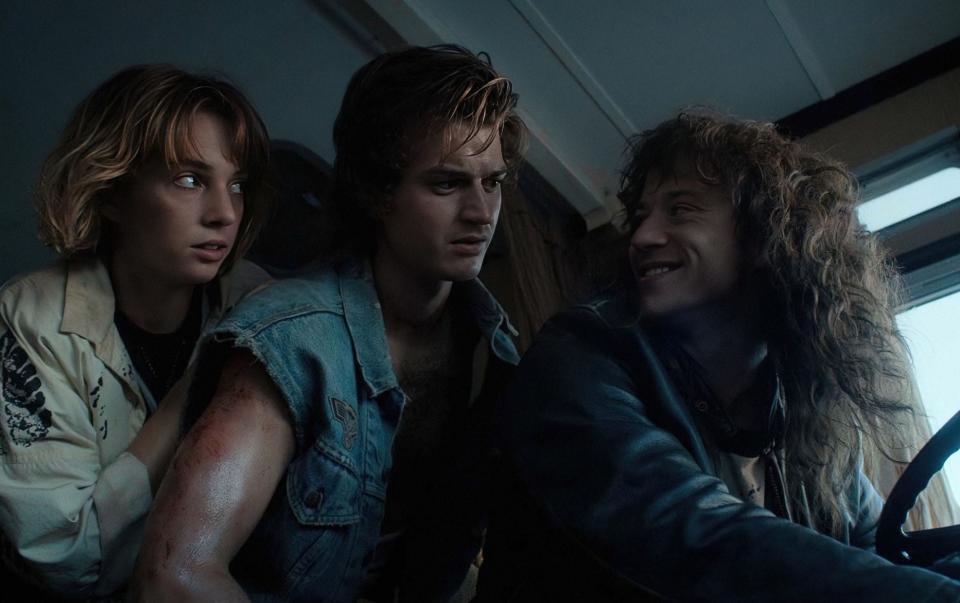Stranger Things 4: what worked, and what didn’t

This was the year Stranger Things turned everything upside down. Characters we were lead to believe long dead were brought back. The new episodes came with epic, Lord of the Rings-esque run-times. And the “big bad” “Mind Flayer” menacing Hawkins all these years was revealed to be a mere trick of the light.
Stranger Things 4 was unquestionably a mega-hit for Netflix – and a timely one given the company’s wobbling subscribers numbers. Eleven and her pals smashed previous streaming records, eclipsing Netflix rivals Tiger King and Ozark. More importantly, from Netflix’s perspective, they thumpingly out-performed their closest summer competitor, Disney +’s Obi-Wan Kenobi in terms of “minutes watched” – the metric by which streaming audiences are assessed. So while Stranger Things 4 surpassed five billion weekly minutes viewed, Ewan McGregor’s Jedi comeback could only scrape past the billion figure. These weren’t the results Disney was looking for.
But that isn’t to say the new Stranger Things is an unqualified success. The lore got a little tangled. Not every twist landed as effectively as it should. And it was hard not to circle back to the traditional criticism of a show which so enthusiastically regurgitates Eighties popular culture. Under all the winks and nods to the past, has Stranger Things anything of its own to say?
Still, you can bet Netflix isn’t complaining and it’s all go for a fifth and final season that could potentially arrive within the next 18 months. “Don’t hold us to it, but the gap should be quite a bit shorter this time, due to the fact that we already have an initial outline, and we can’t imagine there will be another six-month forced [Covid] hiatus,” Stranger Things creators the Duffers brothers told Variety. In the meantime here is our analysis of five aspects of Stranger Things 4 that worked – and five that didn’t. (Warning: spoilers below.)
What worked
1. Kate Bush
Who could have guessed the saviour of Gen Z television would be an Eighties pop star who, in her hit-making prime, was derided by the music press as “bewildering and not a little preposterous”?
Bush and Stranger Things were made for each other, it turns out. The scene in which her 1985 hit Running Up That Hill provides a life-line to Max as her mind is colonised by evil sorcerer Vecna is both visually stunning and emotionally compelling.
The cloud Vecna casts over Max can be read as a metaphor for the depression she is suffering following the death of her brother Billy. And Kate Bush is there for her during her darkest moment. With that, an entire generation is introduced to one of the great luminescent talents of British pop.
“It’s really wonderful,” Bush told Radio 4’s Woman’s Hour. “This is a whole new audience. In a lot of cases, they’d never heard of me. The thought of all the young people hearing the song for the first time… It’s very special.” Running Up That Hill duly went to number one in the UK and cracked the US top 10, generating an estimated £1.9 million in royalties for Bush. No wonder she sounded so cheery.
2. Longer running times
The original Stranger Things is a streaming TV classic. However, the following two seasons feel rushed and repetitive, as the Duffers chase that nostalgia sweet spot in the shadow of a ticking clock. But with the pandemic throwing production into disarray they were finally able to step back and take the time they needed to tell their story properly.
And, as the tale grew in the telling, so did the running length, with several instalments surpassing 90 minutes and the finale blasting through the two-and-a-half hour mark. A wider palette has given Stranger Things room to breath. We are no longer zipping maniacally around Hawkins trying to keep tabs on all our favourite characters. At last, Stranger Things is free to unspool at its own pace.
3. The cast chemistry
The sweet and unexpected friendship between privileged jock Steve (as he was originally introduced) and dorky Dustin has been an ongoing highlight of Stranger Things. This time, however, the chemistry has flowed from the girl-power duo of Nancy and Robin (a chalk-and-cheese pairing who should not have worked but did) and between Dustin and Eddie, the small town metalhead who threatens to usurp Steve at Dustin’s surrogate big brother.

An honourable mention goes to Jonathan and stoner Argyle and their proto-Wayne’s World / Bill and Ted act. It is easy to imagine a universe in which their “woah dude!” routine comes over as insufferable. Here it has the charm of fresh-from-the-oven pizza liberally sprinkled with pineapple.
4. Bringing back Matthew Modine
Blockbuster entertainment lives and dies by its villains. And as Eleven’s mentor and exploiter, Modine’s Dr Brenner is exactly what Stranger Things needs. As confirmed in the final two episodes, he’s a sociopath who thinks he is doing the right thing. And despite seemingly perishing in series one, his return is justified. Modine’s perfectly modulated performance – devoid of scenery chewing or luxuriant cackling – marks him as the true monster.

5. Jamie Campbell Bower as Vecna
“Maaaaaaxxxx.” Features obscured beneath layers of latex, Jamie Campbell Bower has his work cut out injecting a streak of real villainy into evil wizard Vecna.
But he brings a genuine fright factor as the dimension-hopping antagonist. If anything, the British actor is even better in Eleven’s flash-back scenes, where he plays an empathic assistant at Hawkins National Laboratory. For these sequences, Bower has revealed he was instructed by the Duffer brothers to study Edward Norton in Primal Fear.
In that 1996 thriller, Norton played a stuttering former-altar boy with a hidden psychopathic side. And the big reveal that Bower’s character has been manipulating Eleven all along is wonderfully unsettling. The dread factor is dialled all the way up as the future Vecna unleashes a bloodbath with a twitch of his head. It’s enough to make you forgive the series for retrospectively downgrading mega-villain the Mind Flayer to a servant of Vecna.

What didn’t work
1. Metallica
Whatever about Kate Bush, Metallica, as one of the biggest bands on the planet, did not need a Stranger Things bump. Nonetheless, after Eddie plays their 1986 favourite Master of Puppets in the Upside Down, the track leaped to number 26 in the Spotify global playlist. In so doing, it highlights Stranger Things at its most pandering and un-imaginative. As with season three’s excruciating Never Ending Story singalong – at which several characters roll their eyes in season four – this is nostalgia for nostalgia’s sake.
Running Up That Hill fulfils a genuine purpose in the story: its use is entirely justified. However, Master of Puppets is just another example of Stranger Things leaning into a dead-eyed nostalgia for anything and everything from the Eighties. It is hard not to feel at such moments that the real puppet-masters are the Duffers, we the marionettes dancing to their tune.
2. The underwhelming finale
The series concludes with Vecna opening his gate to the Upside Down – and everyone in Hawkins being essentially okay about it. Yes, a few people had been rendered homeless by what the authorities are passing off as a freak earthquake. Yet Eleven and the gang are more concerned with their interpersonal dynamics than with their mortal foe literally bringing hell to earth. And so, in its final flourish, and after all the excitement that had gone before, Stranger Things 4 is unmasked as nothing more than an elaborate set-up for… Stranger Things 5.
3. Letting the main characters live
If there is one thing we have learned from Game of Thrones it’s that nothing grabs the viewer like a shock death. And yet Stranger Things remains unwilling to bump off any of the core cast (though it has sent Max into a coma). Worse yet, in the run-up to the weekend’s two-part finale, the series teased fans by tweeting a billboard that read “Protect Steve”.
This fuelled speculation Steve might die, potentially as a result of the demobat bite he suffered. Instead, the show bumps off newcomer Eddie – who has clearly been introduced to raise the emotional stakes before his inevitable death. Even the cast agrees the wussiness towards characters needs to end.

“It’s way too big. Last night, we couldn’t even take one group picture because there was like 50 of us. I was like, ‘You need to start killing people off,'” complained Millie Bobby Brown of the sprawling line-up.
“The Duffer brothers are two sensitive Sallies that don’t want to kill anyone off. We need to be Game of Thrones. We need to have the mindset of Game of Thrones.”
4. The uneven tone
Stranger Things has always zigzagged between genres. This season, we get Stephen King’s Carrie-style high-school horror as Eleven is bullied in California and slasher-movie hijinks as the Hawkins gang piece together the mystery of Victor Creel. Yet some of these tonal-shifts don’t quite work. Jonathan and Argyl’s stoner comedy – while funny in the moment and well-acted – sits uncomfortably alongside Eleven’s teen angst.
And the Deep State thriller storyline featuring Colonel Sullivan pursuing Eleven never amounts to anything. Why, for instance, don’t his soldiers follow Eleven after she flees the desert laboratory? They just seem to forgot why they are there.
5. Mike Wheeler becoming the least likeable character
Along with Millie Bobby Brown, Finn Wolfhard was the break-out star of Stranger Things season one. But his character Mike has gradually faded into the background and in series four is essentially an after-thought.
Worse yet, he's an irritant. With the fate of the world in the balance, he spends his time grumbling about his relationship with Eleven while being horrible to best pal Will (who clearly has a crush on him). He’s gone from de facto hero to annoying b-lister, and it is hard not to conclude that Wolfhard feels frustrated about the downgrading and that some of that exasperation has leeched into his crabby performance.


